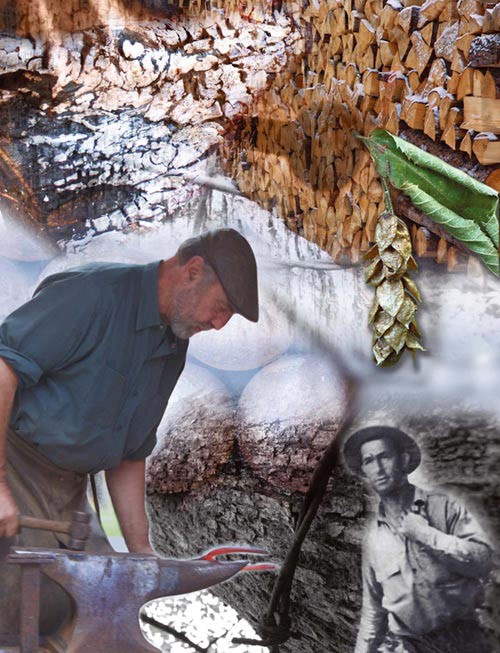My friend John the blacksmith lent me an old book, A Natural History of Trees, by Donald Culross Peattie, which is both quaint and authoritative. Maybe it’s this combination of qualities that made the farrier beam as he handed it to me, saying, “It’s perfect.”
When I got home, I first turned to the chapter on the hophornbeam, a tree I’ve always treasured, although I’ve never really figured out why. After all, it’s a killing wood to chop or work, as I’ve often proved to myself. No wonder its folk names are ironwood and lever-wood. Mr. Peattie muses that “everything about this little tree is at once serviceable and self-effacing. Such members of any society are easily overlooked, but well worth knowing.”
I looked up from that passage and thought of John himself; he’s a bright man, but reticent, self-effacing – and tough as ironwood. And I thought through John, so to speak, to a long-gone friend, Don Chambers, who once told me how he’d cut hornbeam all through one winter. Back in his time, before the arrival of synthetics in any quantity, the rigid and tight-grained wood was used for stretcher handles and coffin-grips. I recall his telling me, “By God, you didn’t want them loads to tumble.”
Illness and death called on the lever-wood’s strengths, so it may be odd for me to make of this scurfy tree a token of life and health. But who’s going to notice, really? And can’t I anyhow forge some symbol from the tree’s fruit, which stands on the branch right on through winter, a mast for deer and grouse and whatever else may seek it? Perhaps searching for another sort of nurture, I’ve now and then plucked some florets to lay on my desk, for however brief a time, as if in the bitter-coldest months, putting them there might also help to sustain a household.
I once used five cord of hophornbeam to heat our house through the winter months, having left the logs unsplit. The maul couldn’t crack them, and when I tried a wedge, I buried it down in the heartwood. There was no way to fetch that metal back but to burn the log and fetch it out of the fire, as John does a shoe.
I smile as I picture him when he handed me his book. He was dressed as always in greens, his beard swept sideways to his face from laying a cheek against the flank of a horse, I suspect. Though he owns a small herd of Suffolk Punch for his own pleasure, he doesn’t make a living putting shoes on working stock these days. In my mind’s eye, he has shaped the shoe on his forge and plunged it deep into the bucket of hissing water, and now is nailing it fast.
I’ve lived my life by words alone for the most part and somehow been more recognized for that than I’d ever have imagined. I’ve been talking and talking and talking, writing and writing and writing, more than ever, and I’ve been doing both for 40 years at that. So as I imagine two terse men who found entirely different ways through the world, steady ones who’ve made more palpable gestures than any I ever have, I get an odd feeling, or perhaps – no definitely – a mixture of feelings. I’d surely be wrong to name it simple envy. It’s better than that. Is it love or admiration – or both? Doubtless. And others, less easy to name.
I dream John whispering not to a saddle horse but to a great blond Belgian gelding. He holds the nails in his teeth, the hoof as wide as an old-time privy seat-cover.
And, under a sky so blue it’s really some other color, also beyond description, Don still drives his saw through ironwood, his wire spectacles glinting in the January sun. Even through his plaid mackinaw, I can see those cannonball biceps in his short arms. If he took off his chopper’s mitts to greet me, I’d feel the calluses of decades in the north woods.
It would be a good thing, I surmise, to let these good and honest men direct me at least for the rest of the day. In another era, this might be the point at which the author addressed his “gentle reader,” tacking on a moral of some sort. And since I am, precisely, summoning two figures from another era, I’ll go ahead and do it, minus the moral, because I can’t say what my moral would be:
Gentle reader, perhaps you will tell me that these things and people and labors that so obsess me are worth nobody’s notice in our time, that I’m only sentimental, that the best thing I might do would be to write a poem, a not untypical elegy, or even a book of poems about all such matter. Even if I did, of course, it would scarcely be what John calls a perfect book. That’s beyond the reach of a wordsmith, even if perfection might be possible for a blacksmith, or for a dear old lumberjack, the one who – along with a horseman – started me thinking this way in the first place.


